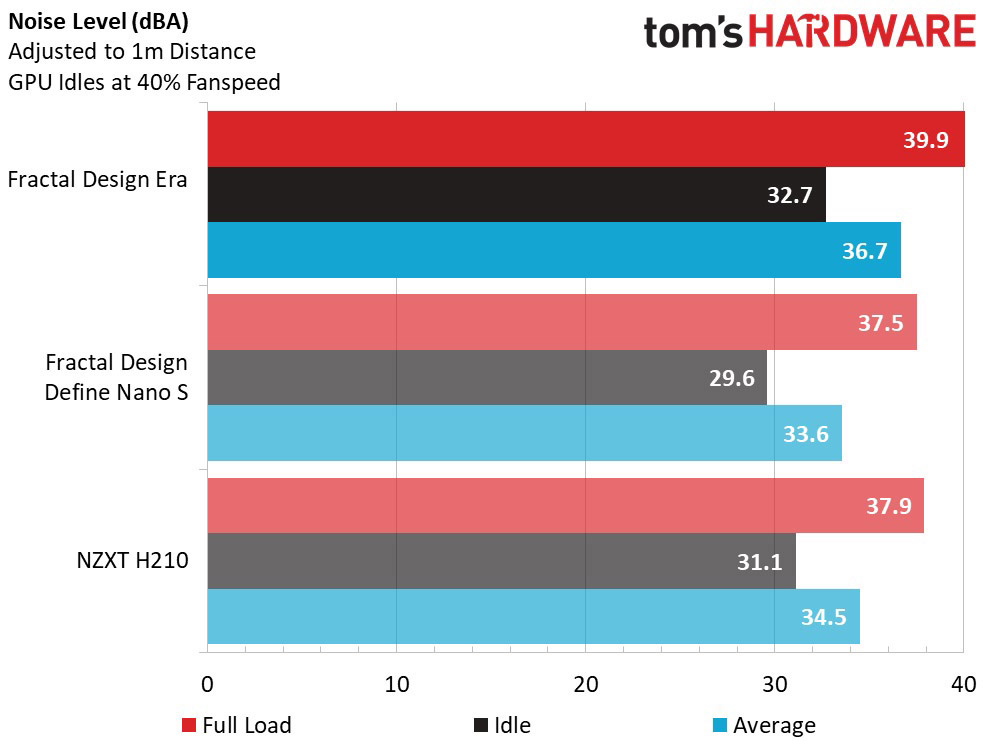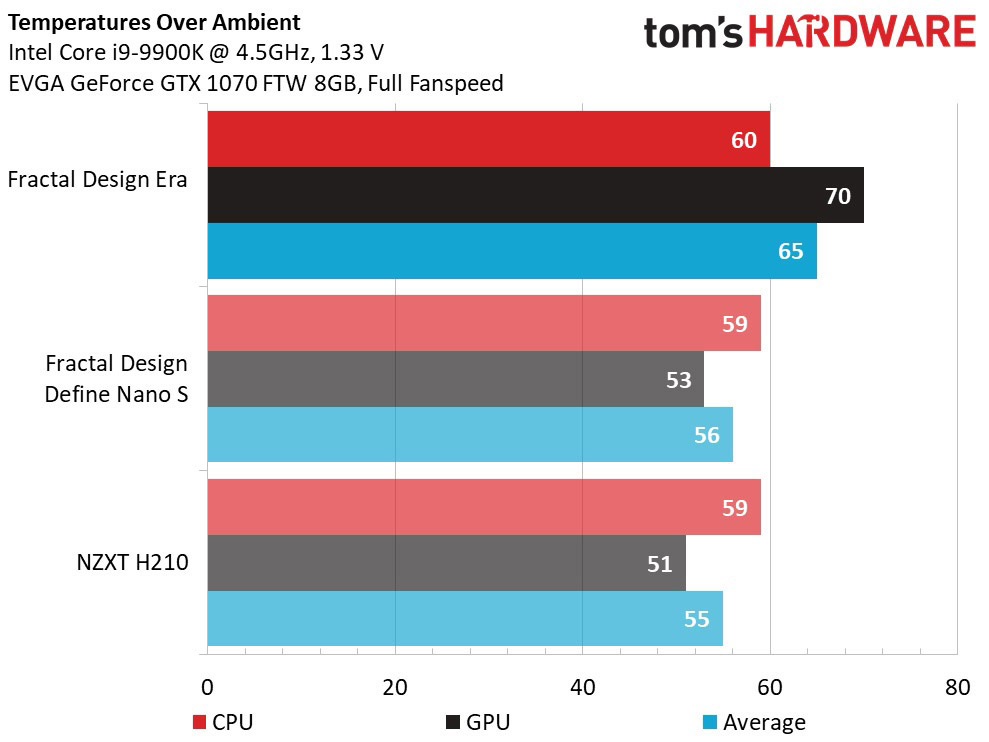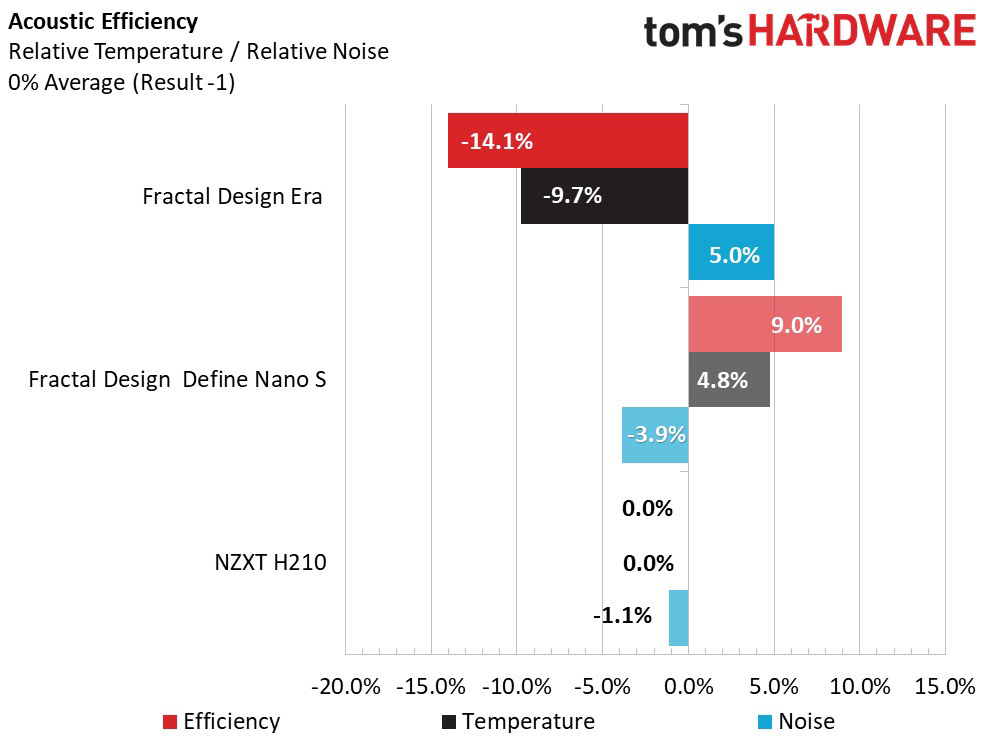Why you can trust Tom's Hardware
We tested the Fractal Design Era with an Intel Core i9-9900K mated to a Corsair 240mm all-in-one cooler. Due to height restrictions and poor airflow, we would not recommend using an air cooled heatsink in this chassis, especially with high-end components. For comparison purposes, we brought in the Fractal Design's own Define Nano S and the Cooler Master MasterCase H100, to give you a good idea how the Fractal Design Era chassis compares to its competitors with similar sizes and feature sets.
The 80mm exhaust fan is woefully lacking in its ability to draw cool air into the chassis from the vents on the sides and bottom. With the vented top panel in place, CPU temperatures leveled off at 60 degrees Celsius over ambient thanks in large part to the 240mm AIO cooler. GPU temperatures maxed out at 70 degrees Celsius over the ambient room temperature. While it undoubtedly looks better, using the tempered glass top panel caused a 10% temperature increase in both the CPU and GPU.

As always, sound pressure level readings were taken with two off-the-shelf dB meters from two different angles. With fan speeds set at the maximum 1,200 rpm, our test system registered a 32.2dBA at idle. With the test system under load, sound output reached a maximum of 39.9.dBA. One of the reasons for the high system noise under load is due to the lack of airflow to the GPU. This in turn resulted in higher-than-average temperatures, causing higher GPU fan speed, generating more noise.
Bottom Line
The Fractal Design Era's extremely elegant design is definitely its biggest selling point. Builders looking to assemble a modest system with a focus on aesthetics over performance (say, a home theater / living room PC) will love this case. Although the difficulties we encountered cannot be overlooked, careful planning and component selection can mitigate many of the issues we found with this chassis.
That said, $160 is very expensive for a mini-ITX case that lacks tempered glass side panels, ARGB functionality, a fan hub, and other features that come standard on many (less expensive) cases offered by competitors. So if you opt for the Era, do so for its looks, rather than value or cooling performance. The former is down to taste, but there’s little doubt that competing cases do better on the two other fronts.
Get Tom's Hardware's best news and in-depth reviews, straight to your inbox.
Current page: Benchmark Results and Conclusion
Prev Page Hardware Installation and Test ConfigurationSteven Lynch is a contributor for Tom’s Hardware, primarily covering case reviews and news.
-
2Be_or_Not2Be "For comparison purposes, we brought in the Fractal Design's own Define Nano S and the Cooler Master MasterCase H100, "Reply
Need to edit your link: all of the charts reference the NZXT H210, not the CoolerMaster H100. -
WildCard999 Reply
And if someone goes that route there's the InWin Chopin or Asrock Deskmini which are not only cheaper but more portable/take up less desk space.Phaaze88 said:Basically, it's fine for an Apu only build. -
Phaaze88 Reply
Ouch.WildCard999 said:And if someone goes that route there's the InWin Chopin or Asrock Deskmini which are not only cheaper but more portable/take up less desk space.
Those look nicer too.
Seriously, there's too much form over function crap as it is. Why hasn't it died down yet?
Oh right - because people keep buying into it...
Then they later come here, or to some other site questioning why things have gone to the dumpster...:rolleyes:

